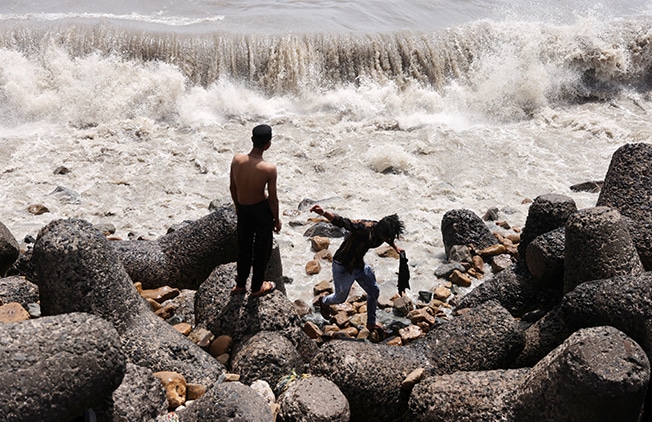Wind speeds and rainfall picked up on India’s Gujarat coast late on Thursday, officials said, after authorities there and in neighbouring Pakistan evacuated more than 180,000 people in the path of approaching cyclone Biparjoy.
Biparjoy, which means ‘disaster’ or ‘calamity’ in the Bengali language, was centred in the Arabian Sea 50 kilometres (31 miles) off Jakhau port in the western Indian state and 240 km (150 miles) off Pakistan’s southern port of Karachi, weather officials said.
As Gujarat’s weather worsened, India’s met department said the cyclone was poised to make landfall.
“Its wall cloud region is entering into the coastal districts and, hence, the landfall process has commenced over the coastal districts,” said Mrutyunjay Mohapatra, director general at the India Meteorological Department (IMD) “By midnight the eye of the cyclone will be on land.”
The IMD said in a bulletin that the cyclone could cause tidal waves in the Arabian Sea as high as 2 m to 3 m (7 to 10 ft) that could inundate low-lying coastal areas in both countries.
Classified as a category one storm, the least severe on a scale of one to five, Biparjoy appeared to have lost some of its intensity.
It was expected to have a maximum sustained wind speed of 115 to 125 kph (71 to 78 mph) gusting up to 140 kph (87 mph), down from Wednesday’s estimate of 150 kph (93 mph).
More than 100,000 people have been evacuated from eight coastal districts in Gujarat and moved to shelters, the state government said.
Authorities said evacuations have been completed in Pakistan, where about 82,000 people were moved from high-risk coastal areas.
Makeshift relief quarters were set up in school auditoriums and other government buildings to shelter the displaced in both countries.
HIGH WAVES, STRONG WIND
As the storm neared land, the windspeed rose around Jakhau, said Amit Arora, a revenue official in the region of Kutch, where the cyclone is likely to hit land and more than 50,000 people have been evacuated.
“There is some rain, but it’s not very heavy rain. We are monitoring the situation and waiting for the landfall,” Arora said, adding witnesses had reported strong winds.
Indian television footage showed high waves in many coastal areas of Gujarat, coupled with heavy rain and strong wind.
In the coastal town of Mandvi, a Reuters witness said strong winds had uprooted trees and caused waterlogging. Other districts in the state also reported fallen trees and moderate rain.
Ships and boats have been moved from some areas of Pakistan’s coast with hospitals put on high alert for the cyclone.
Karachi, an economic hub of 20 million, faced no immediate threat, but emergency measures were being taken to protect against the expected winds and rain, said Sherry Rehman, Pakistan’s climate change minister.
“There is no need to panic. Such storms are always unpredictable. But rest assured that we have all our arrangements in place,” said Rehman.
Temporary thatched homes in coastal Gujarat could be flattened while standing crops, plantations and roads are threatened with major damage, the IMD said in a statement that cautioned over disruptions to the railway network.
Indian authorities suspended fishing until Friday, shut schools and closed beaches. Many offshore oil installations and major ports on the Gujarat coast have suspended operations.






